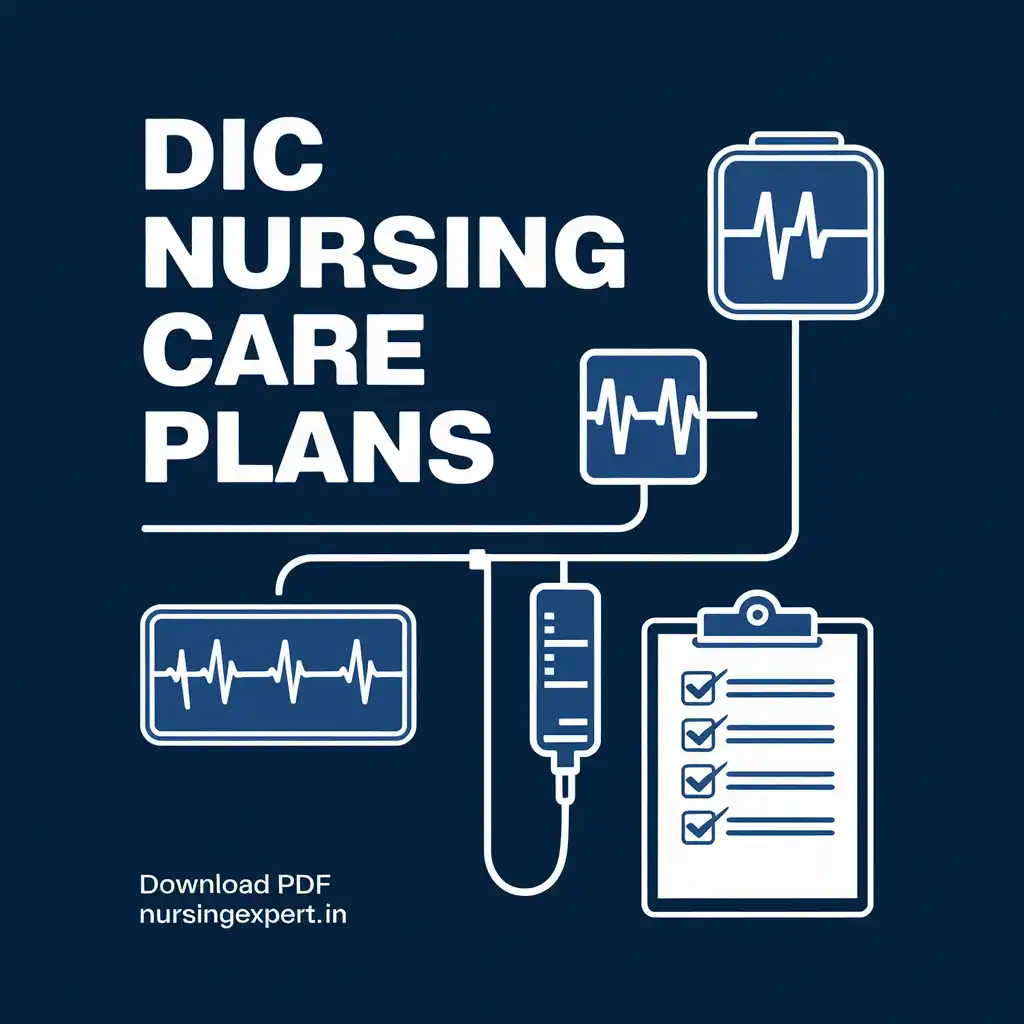Disseminated Intravascular Coagulation Nursing Care Plan: Disseminated Intravascular Coagulation (DIC) is a complex, life-threatening condition in which widespread clotting depletes platelets and clotting factors, leading to both thrombosis and bleeding. Prompt identification and management are crucial for patient survival. Nursing care plans for DIC provide a structured, evidence-based framework to guide interventions that stabilize the patient, manage bleeding and clotting, and support organ function. This guide outlines eight comprehensive nursing care plans for DIC management, including a sample 7-column template and a downloadable PDF resource available at NursingExpert.in.
Thank you for reading this post, don't forget to subscribe!
Introduction
Disseminated Intravascular Coagulation (DIC) is a critical condition that challenges even experienced healthcare professionals. It results from a dysregulated coagulation cascade, leading to simultaneous clot formation and bleeding. Nursing care plans for DIC are essential for guiding rapid, evidence-based interventions that stabilize the patient and prevent further complications. This guide provides eight detailed nursing care plans designed for various aspects of DIC management and includes a sample 7-column template. A downloadable PDF resource is available at NursingExpert.in to support your clinical practice.


Understanding Disseminated Intravascular Coagulation (DIC)
DIC is a syndrome characterized by widespread activation of coagulation pathways, resulting in microvascular thrombosis and subsequent consumption of platelets and clotting factors. Key aspects include:
- Pathophysiology: Triggered by an underlying condition (e.g., sepsis, trauma, malignancy) that leads to systemic inflammation and coagulation cascade activation.
- Clinical Presentation: Patients may present with signs of both clotting (e.g., organ dysfunction, ischemia) and bleeding (e.g., petechiae, hemorrhage).
- Diagnosis: Based on clinical signs, laboratory findings (e.g., prolonged clotting times, low platelet count, elevated D-dimer), and imaging studies.
- Management: Involves treating the underlying cause, supportive care, and meticulous monitoring of coagulation parameters.
The Importance of Nursing Care Plans for DIC
Nursing care plans for DIC are crucial because they:
- Standardize Care: Provide consistent, evidence-based protocols for managing a complex condition.
- Facilitate Early Recognition: Enable prompt identification of deteriorating coagulation status.
- Enhance Communication: Serve as a clear roadmap for interdisciplinary collaboration.
- Improve Outcomes: Guide interventions that stabilize the patient and prevent complications such as organ failure.
- Educate Families: Inform caregivers about the condition, treatment, and necessary follow-up care.
A structured care plan ensures timely, coordinated care and enhances patient safety.
The Nurse’s Role in DIC Management
Nurses are at the frontline of DIC management and play a key role in:
- Assessment: Rapidly gathering patient history, vital signs, and laboratory values to assess coagulation status.
- Monitoring: Continuously observing for signs of bleeding and clotting, and tracking changes in clinical status.
- Intervention: Administering medications (e.g., anticoagulants, blood products), providing fluid therapy, and supporting organ function.
- Education: Informing patients and families about DIC, its causes, treatment, and necessary precautions.
- Documentation: Keeping accurate records of assessments, interventions, and patient responses.
- Collaboration: Coordinating with physicians, pharmacists, and laboratory personnel for comprehensive care.
Key Components of an Effective Nursing Care Plan
An effective nursing care plan for DIC should include:
- Comprehensive Assessment: Detailed evaluation of clinical signs, lab values, and patient history.
- Nursing Diagnosis: Identification of issues such as ineffective tissue perfusion, bleeding risk, and acute pain.
- Nursing Goals: Clear, measurable outcomes aimed at stabilizing the patient’s condition.
- Nursing Interventions: Evidence-based actions tailored to address each nursing diagnosis.
- Evaluation: Continuous monitoring to assess progress and adjust the care plan.
- Documentation: Accurate recording of all interventions and patient outcomes to ensure continuity of care.
Nursing Diagnoses for Disseminated Intravascular Coagulation
Common nursing diagnoses for DIC include:
- Ineffective Tissue Perfusion: Due to microvascular thrombosis and impaired blood flow.
- Risk for Bleeding: Resulting from depletion of clotting factors and platelets.
- Acute Pain: Associated with ischemia and tissue injury.
- Risk for Shock: Due to circulatory collapse and organ dysfunction.
- Anxiety: Related to the life-threatening nature of the condition.
- Knowledge Deficit: Concerning DIC, treatment protocols, and self-care.
Nursing Goals for Disseminated Intravascular Coagulation Patients
Short-Term Goals
- Stabilize Hemodynamics: The patient will maintain stable blood pressure, heart rate, and oxygen saturation within 1-2 hours.
- Improve Tissue Perfusion: The patient will exhibit improved peripheral perfusion as evidenced by warm extremities and adequate urine output within 48 hours.
- Control Bleeding: The patient will show no signs of active bleeding within 24 hours.
- Reduce Pain: The patient will report pain ≤3/10 within 1 hour of intervention.
- Enhance Family Understanding: Caregivers will demonstrate understanding of the care plan within 24 hours.
Long-Term Goals
- Prevent Organ Failure: The patient will show no progression of organ dysfunction on follow-up evaluations.
- Achieve Full Stabilization: The patient will gradually return to baseline function as indicated by laboratory and clinical parameters.
- Maintain Safety: The patient will remain free of complications such as significant hemorrhage or thrombotic events.
- Sustain Knowledge: The patient and family will adhere to follow-up care and preventive measures.
Nursing Interventions and Actions
Pre-Treatment Interventions
- Rapid Assessment: Evaluate the patient’s airway, breathing, circulation, and coagulation status immediately.
- Patient and Family Education: Explain the urgency of the condition, treatment plans, and potential complications.
- Prepare Equipment: Ensure that necessary equipment (oxygen, IV access, blood products) is readily available.
Treatment Interventions
- Medication Administration: Administer anticoagulants, blood products, or clotting factors as ordered.
- Fluid Management: Initiate IV fluid therapy to support circulation and tissue perfusion.
- Oxygen Therapy: Provide supplemental oxygen to maintain adequate saturation.
- Monitor Vital Signs: Continuously assess heart rate, blood pressure, and oxygen levels.
- Pain Management: Administer analgesics and non-pharmacological pain relief measures.
- Emotional Support: Offer reassurance and clear explanations to reduce anxiety.
Post-Treatment Interventions
- Ongoing Monitoring: Regularly reassess coagulation parameters, organ function, and overall clinical status.
- Reinforce Education: Reiterate treatment plans and signs of complications to caregivers.
- Document Progress: Keep detailed records of interventions, responses, and adjustments to the care plan.
- Plan Follow-Up: Coordinate with the healthcare team for continued monitoring and follow-up appointments.
Sample Disseminated Intravascular Coagulation Nursing Care Plan Template
| Nursing Diagnosis | Patient Goals/Expected Outcomes | Assessment Data | Nursing Interventions | Rationale | Evaluation | Documentation/Follow-Up |
|---|---|---|---|---|---|---|
| Ineffective Tissue Perfusion | Maintain stable tissue perfusion; warm extremities and urine output ≥0.5 mL/kg/hr within 48 hours | Hypotension; cool extremities; low urine output | Administer IV fluids; monitor vital signs; adjust vasopressor therapy as needed | Enhances blood flow and oxygen delivery to tissues | Improved peripheral perfusion; urine output within target range | Document fluid management and vital signs regularly |
| Risk for Bleeding | No active bleeding observed; coagulation profile stabilizes within 24 hours | Low platelet count; prolonged clotting times; petechiae | Monitor coagulation parameters; administer blood products/clotting factors as prescribed; use gentle handling techniques | Prevents hemorrhage by supporting coagulation function | Bleeding controlled; lab values improve | Record lab results and intervention outcomes |
| Acute Pain | Report pain ≤3/10 within 1 hour | Patient reports pain score of 6/10; signs of discomfort | Administer prescribed analgesics; use non-pharmacological pain relief techniques (e.g., guided imagery) | Alleviates pain and facilitates comfort | Pain score decreases; patient appears more comfortable | Document pain assessments and medication administration |
| Risk for Shock | Maintain stable hemodynamic status within 1 hour | Hypotension; tachycardia; signs of poor perfusion | Initiate IV fluid resuscitation; monitor EKG; adjust vasopressor therapy as needed | Prevents circulatory collapse and supports organ perfusion | Hemodynamic parameters stabilize; no signs of shock | Record EKG and vital signs frequently |
| Anxiety | Patient and family report reduced anxiety within 30 minutes | Signs of anxiety; verbal expressions of fear | Provide clear explanations; offer reassurance; use relaxation techniques | Reduces stress and promotes a calm environment | Anxiety decreases; positive verbal feedback | Document emotional support interventions |
| Knowledge Deficit | Patient and family will accurately describe the care plan within 30 minutes | Family asks questions about DIC management | Provide detailed verbal and written education; use teach-back methods | Ensures informed participation and adherence to treatment | Family demonstrates understanding; compliant with instructions | Document education sessions and verify comprehension |
| Risk for Organ Dysfunction | Prevent progression to multi-organ failure; stabilize organ function within 48 hours | Elevated lactate; abnormal liver and renal function tests | Monitor lab values regularly; collaborate with the medical team; adjust interventions as needed | Early detection and intervention reduce risk of organ failure | Organ function stabilizes; lab values return to acceptable range | Document lab results and interventions |
Customize this template to fit the specific clinical scenario of each patient.
Downloadable PDF Resource
For your convenience, a detailed Nursing Care Plan for Disseminated Intravascular Coagulation is available as a downloadable PDF. This ready-to-use template can be printed or saved for reference in your clinical practice.
Download the DIC Nursing Care Plans PDF Here at NursingExpert.in
Customizing Your Care Plan
Each patient with DIC presents unique challenges. Customize your care plan by:
- Conducting a Detailed Assessment: Gather comprehensive clinical data including vital signs, laboratory results, and patient history.
- Setting Specific Goals: Define measurable outcomes based on the patient’s condition and response to treatment.
- Selecting Targeted Interventions: Choose evidence-based interventions that address both acute symptoms and long-term complications.
- Documenting Accurately: Keep precise records of all assessments, interventions, and patient responses.
- Reviewing Regularly: Continuously monitor patient status and update the care plan accordingly.
A personalized care plan is essential for optimal management of DIC.
Evaluation and Monitoring
Ongoing evaluation is critical:
- Review Assessments: Regularly compare current clinical data with baseline measurements.
- Measure Progress: Monitor improvements in vital signs, perfusion, and lab values.
- Adjust Interventions: Modify the care plan based on continuous assessments.
- Document Outcomes: Record all observations and changes to ensure effective communication among the care team.
Overcoming Challenges in DIC Nursing Care
Challenges in managing DIC include:
- Rapid Clinical Deterioration: Requires continuous monitoring and swift intervention.
- Multisystem Involvement: Demands coordinated, interdisciplinary care.
- Risk of Bleeding and Thrombosis: Requires delicate balancing of interventions.
- Family Anxiety: Necessitates clear communication and thorough education.
- Complex Treatment Regimens: Involves strict adherence to fluid, medication, and monitoring protocols.
Effective communication, proactive interventions, and interdisciplinary collaboration are key to overcoming these challenges.
Best Practices
For high-quality, patient-centered care:
- Utilize Evidence-Based Interventions: Follow current clinical guidelines and research.
- Maintain Clear Documentation: Accurately record all patient data and interventions.
- Educate Continuously: Empower patients and families with comprehensive, understandable information.
- Collaborate Interdisciplinarily: Work closely with physicians, pharmacists, and other healthcare professionals.
- Conduct Regular Reassessments: Continuously update the care plan based on patient progress.
Frequently Asked Questions (FAQs)
- What is Disseminated Intravascular Coagulation (DIC)?
DIC is a critical condition where widespread clotting depletes platelets and clotting factors, leading to both thrombosis and bleeding. - How quickly do DIC symptoms progress?
DIC can progress rapidly, often within hours, making early recognition and intervention vital. - What are the main interventions in DIC care plans?
Interventions typically include fluid resuscitation, medication administration (anticoagulants, blood products), and continuous monitoring of vital signs and laboratory values. - How can nurses reduce anxiety in patients with DIC?
Nurses reduce anxiety by providing clear explanations, emotional support, and involving the family in the care plan. - Where can I download the DIC Nursing Care Plans PDF?
You can download the free, ready-to-use PDF resource from NursingExpert.in.
Conclusion
DIC is a complex, rapidly evolving condition that demands immediate and coordinated care. A comprehensive nursing care plan that addresses tissue perfusion, bleeding, pain management, and emotional support is essential for stabilizing patients and preventing further complications. By implementing evidence-based interventions and continuously monitoring patient progress, nurses can significantly improve outcomes. Use this guide and the downloadable PDF resource from NursingExpert.in to enhance your clinical practice and deliver life-saving care.
References and Sources
- National Institutes of Health (NIH). (2023). Severe Allergic Reactions and Anaphylaxis. Retrieved from https://www.nih.gov
- Centers for Disease Control and Prevention (CDC). (2023). DIC: Overview and Management. Retrieved from https://www.cdc.gov
- American Nurses Association (ANA). (2022). Standards for Nursing Practice. Retrieved from https://www.nursingworld.org
- Surviving Sepsis Campaign. (2023). International Guidelines for Management of Sepsis and Septic Shock. Retrieved from https://www.survivingsepsis.org
- MedlinePlus. (2023). Disseminated Intravascular Coagulation (DIC). Retrieved from https://medlineplus.gov


